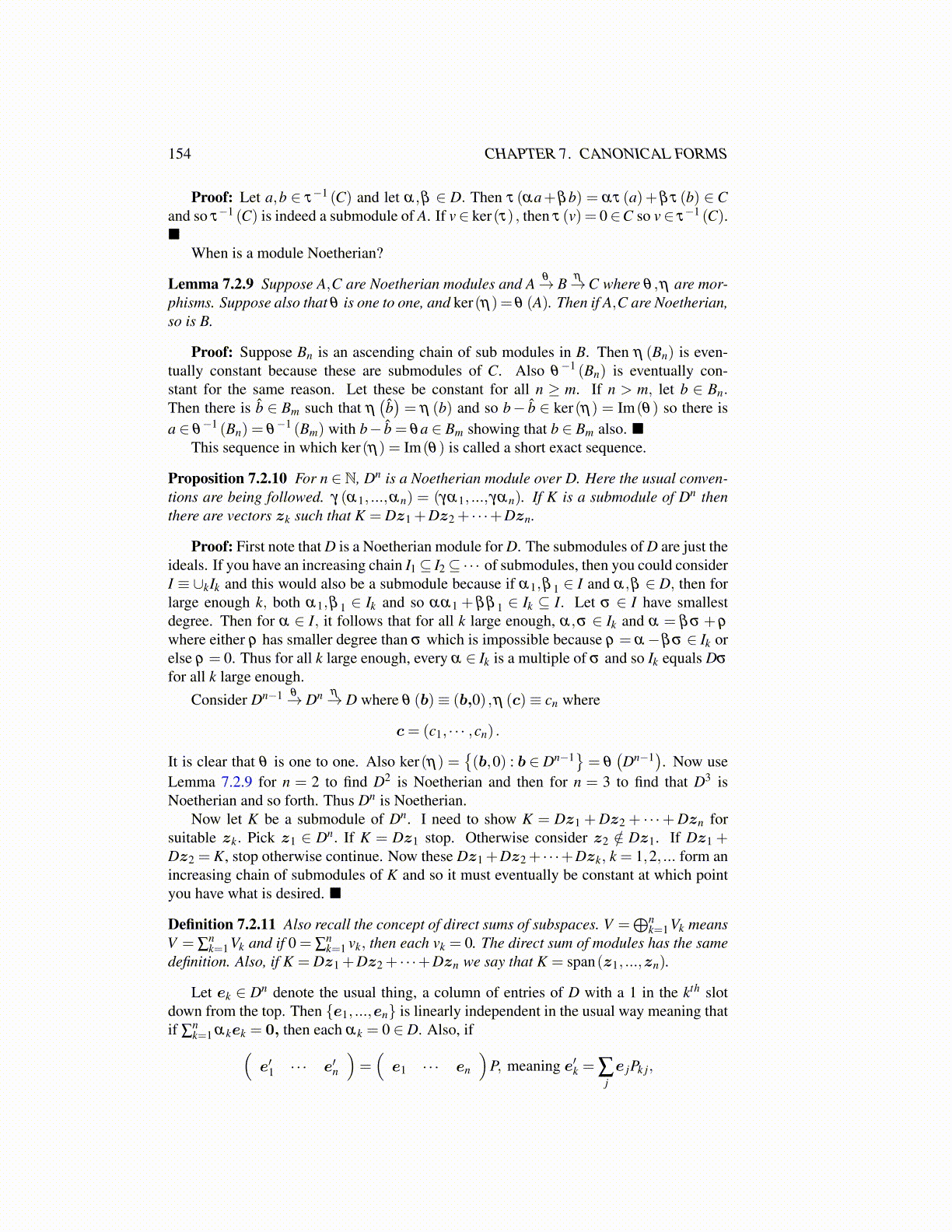
154 CHAPTER 7. CANONICAL FORMS
Proof: Let a,b ∈ τ−1 (C) and let α,β ∈ D. Then τ (αa+βb) = ατ (a)+βτ (b) ∈ Cand so τ−1 (C) is indeed a submodule of A. If v∈ ker(τ) , then τ (v) = 0∈C so v∈ τ−1 (C).■
When is a module Noetherian?
Lemma 7.2.9 Suppose A,C are Noetherian modules and A θ→ Bη→C where θ ,η are mor-
phisms. Suppose also that θ is one to one, and ker(η) = θ (A). Then if A,C are Noetherian,so is B.
Proof: Suppose Bn is an ascending chain of sub modules in B. Then η (Bn) is even-tually constant because these are submodules of C. Also θ
−1 (Bn) is eventually con-stant for the same reason. Let these be constant for all n ≥ m. If n > m, let b ∈ Bn.Then there is b̂ ∈ Bm such that η
(b̂)= η (b) and so b− b̂ ∈ ker(η) = Im(θ) so there is
a ∈ θ−1 (Bn) = θ
−1 (Bm) with b− b̂ = θa ∈ Bm showing that b ∈ Bm also. ■This sequence in which ker(η) = Im(θ) is called a short exact sequence.
Proposition 7.2.10 For n ∈ N, Dn is a Noetherian module over D. Here the usual conven-tions are being followed. γ (α1, ...,αn) = (γα1, ...,γαn). If K is a submodule of Dn thenthere are vectors zk such that K = Dz1 +Dz2 + · · ·+Dzn.
Proof: First note that D is a Noetherian module for D. The submodules of D are just theideals. If you have an increasing chain I1⊆ I2⊆ ·· · of submodules, then you could considerI ≡ ∪kIk and this would also be a submodule because if α1,β 1 ∈ I and α,β ∈ D, then forlarge enough k, both α1,β 1 ∈ Ik and so αα1 + ββ 1 ∈ Ik ⊆ I. Let σ ∈ I have smallestdegree. Then for α ∈ I, it follows that for all k large enough, α,σ ∈ Ik and α = βσ +ρ
where either ρ has smaller degree than σ which is impossible because ρ = α−βσ ∈ Ik orelse ρ = 0. Thus for all k large enough, every α ∈ Ik is a multiple of σ and so Ik equals Dσ
for all k large enough.Consider Dn−1 θ→ Dn η→ D where θ (b)≡ (b,0) ,η (c)≡ cn where
c= (c1, · · · ,cn) .
It is clear that θ is one to one. Also ker(η) ={(b,0) : b ∈ Dn−1
}= θ
(Dn−1
). Now use
Lemma 7.2.9 for n = 2 to find D2 is Noetherian and then for n = 3 to find that D3 isNoetherian and so forth. Thus Dn is Noetherian.
Now let K be a submodule of Dn. I need to show K = Dz1 +Dz2 + · · ·+Dzn forsuitable zk. Pick z1 ∈ Dn. If K = Dz1 stop. Otherwise consider z2 /∈ Dz1. If Dz1 +Dz2 = K, stop otherwise continue. Now these Dz1 +Dz2 + · · ·+Dzk, k = 1,2, ... form anincreasing chain of submodules of K and so it must eventually be constant at which pointyou have what is desired. ■
Definition 7.2.11 Also recall the concept of direct sums of subspaces. V =⊕n
k=1 Vk meansV = ∑
nk=1 Vk and if 0 = ∑
nk=1 vk, then each vk = 0. The direct sum of modules has the same
definition. Also, if K = Dz1 +Dz2 + · · ·+Dzn we say that K = span(z1, ...,zn).
Let ek ∈ Dn denote the usual thing, a column of entries of D with a 1 in the kth slotdown from the top. Then {e1, ...,en} is linearly independent in the usual way meaning thatif ∑
nk=1 αkek = 0, then each αk = 0 ∈ D. Also, if(
e′1 · · · e′n
)=(
e1 · · · en
)P, meaning e′k = ∑
je jPk j,